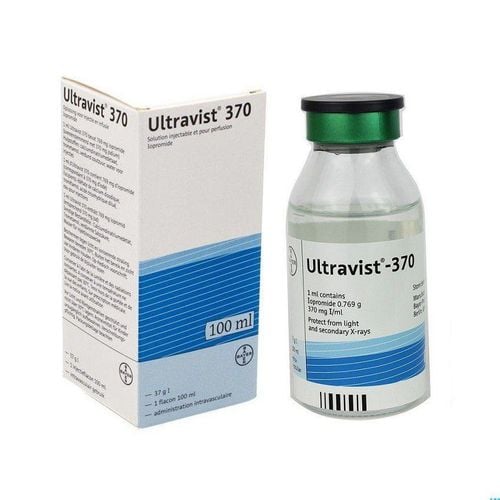This is an automatically translated article.
Fasran inj 350 is a solution used before X-ray imaging tests to find problems in the heart, head, blood vessels, stomach, bladder, kidneys, reproductive tract and organs other of the body. So how to use Fasran inj 350, what should be noted? Read the article below to get more useful information about this drug.
1. What are the uses of Fasran inj 350?
Iohexol in the drug is a non-ionizing, iodine-containing contrast agent. The drug has the ability to increase the absorption of X-rays in the parts of the body through which the drug passes, thereby improving the images obtained, making it easier for your doctor to diagnose your condition. The level of contrast of the drug is proportional to the concentration and volume of the iodinated contrast material in the path of the X-ray.
Therefore, Fasran inj 350 is used in the following cases:
Regular CT Scan , multi-layer cutting, spiral. Angiography, angioplasty, monitoring of coronary bridges: coronary arteries, cardiac circulation, aorta, abdominal arteries, arteries of some viscera, peripheral veins. X-ray examination of the urinary system through the vein (UIV- Digitalized urogram).
2. How to use Fasran inj 350?
When used in the circuit, the drug dosage depends on the location of the organ to be investigated, specifically:
In adults:
Ventrography: 40ml (30 to 60ml); may repeat but not more than 250ml. Selective coronary angiography: each injection of 5ml (from 3 to 14 ml). Study of the main aorta and aortic arch: 50ml (20 to 75ml) as monotherapy. Pulmonary angiogram: for every 1 kg of body weight, use 1 ml of the drug. Combined use in angiography: The total dose should not exceed 5 mg per kg body weight or 250 ml. Aortic and selective coronary angiography: Aorta 50 to 80 ml; main branch artery including abdominal branch, mesenteric artery: 30 to 60ml; Renal artery: 5 to 15 ml, if repeated injection, the total dose should not exceed 250 ml of Fasran inj 350 solution. Cerebral angiogram: Common carotid artery: 6 to 12ml. Internal carotid artery: 8 to 10ml. External carotid artery: 6 to 9 ml. Vertebral artery: 6 to 10ml. In children:
Ventricular scan: use 1 to 1.5 ml of a solution of 350 mg/ml of iodine per kg body weight, when needed for a booster injection, not more than 5 ml/kg or 250 ml. Pulmonary angiography: 1 ml per kg body weight. Selective carotid and angiography: single dose 1ml/kg, do not exceed 5ml/kg or 250ml when repeat injection is required. Whole body CT scan in adults: Brain CT is indicated to inject 80ml of Fasran solution 350 CT body: Inject 60 to 100ml of Fasran solution 350 CT body in children: 60 to 100ml injection Translate Fasran inj 350 . Digital exclusion radiographs in adults typically inject 30 to 50 ml of this drug solution, 7.5 to 30 ml/sec by injection with a pressure syringe. UIV in adults 200 to 350 mg iodine/kg. Gastrointestinal tract: 50 to 100 ml of Fasran inj 350 solution, undiluted, depending on the nature of the procedure and the size of the patient.
3. Notes when using Fasran inj 350
Do not use Fasran inj 350 for the following subjects:
Hypersensitivity to Iohexol, Iodine or any component of the drug. Ever had anaphylaxis or a late skin reaction to an iodine-containing injection. Obvious thyroid toxicity. Imaging of the uterus and fallopian tubes in pregnant women. History of allergies or asthma, diabetes mellitus, severe renal impairment Children and the elderly. Do not administer intrathecal injection in chronic alcoholics, those with subarachnoid hemorrhage, history of seizures, active systemic or severe local infections, or disseminated sclerosis. Do not inject intravascularly in patients with sickle cell disease, hyperthyroidism, and pheochromocytoma. Do not use in cardiology in people with heart failure onset, people with severe pulmonary hypertension. Unstable angina. Do not use the drug in cerebral angiography in people with severe arteriosclerosis, decompensated heart failure, recent cerebral infarction, severe hypertension, thrombosis or senility. UIV imaging is contraindicated in people with anuria - diabetes. Fasran inj 350 should not be used in X-rays of the uterus - ovaries during menstruation, pregnancy, infection, postpartum, at least 6 months or 30 days after removal of a tissue sample from the cervix. In nursing women it is advised not to breastfeed for 24 hours after taking this medicine. Medicines can cause headaches and dizziness, so if you do things like driving or operating machinery, you should only do them when you have made sure the medicine is no longer effective. Overdose of Fasran inj 350 only occurs when very high doses are used. At this time, the patient will be rehydrated, electrolytes, renal function monitored, symptomatic treatment and support.
4. Drug interactions and side effects of Fasran inj 350
4.1 Drug Interactions Fasran inj 350 is not recommended with Metformin. Your doctor may decide not to use this medicine or change certain other medicines.
Using Fasran inj 350 with any of the following medicines is not recommended, but if both are needed, your doctor may change the dose or frequency of using one or both of them.
Acebutolol Amiodarone Atenolol Betaxolol Bisoprolol Carvedilol Celiprolol Esmolol Propranolol 4.2 Side effects Along with the necessary effects, Fasran inj 350 medicine can cause some unwanted effects. Not all of these effects are possible, but if they do, you may need medical advice or help.
More common side effects such as: Arm, back or jaw pain, chest pain, shortness of breath, fainting, nausea... Less common symptoms include: Blurred vision, dizziness , temporary vision loss, vomiting... Some side effects may occur and go away without medical attention. Health care professionals can tell you about ways to prevent or reduce some of these effects.
Please dial HOTLINE for more information or register for an appointment HERE. Download MyVinmec app to make appointments faster and to manage your bookings easily.













